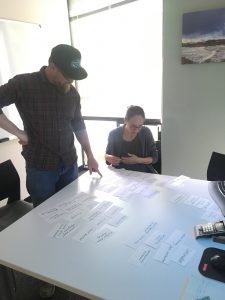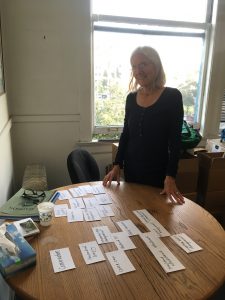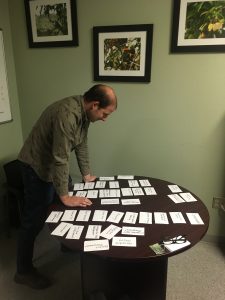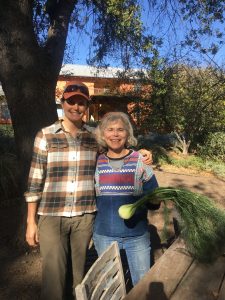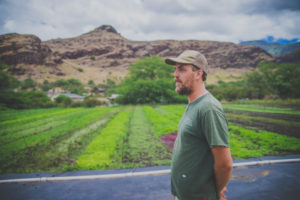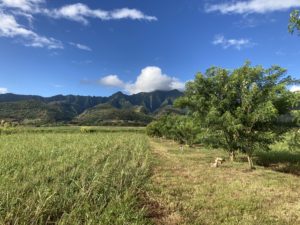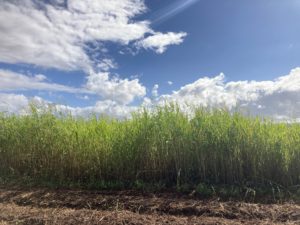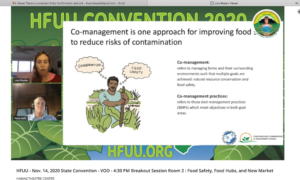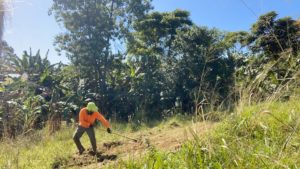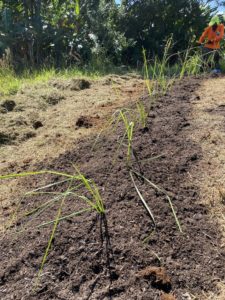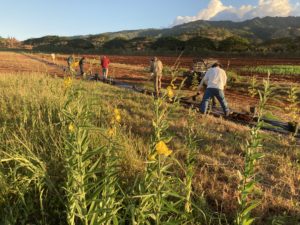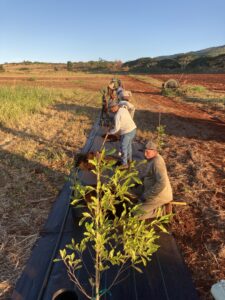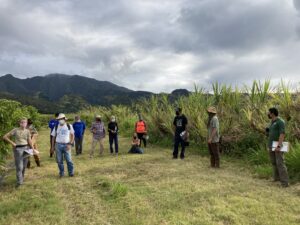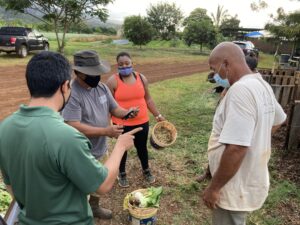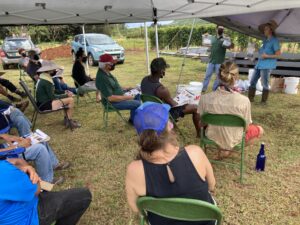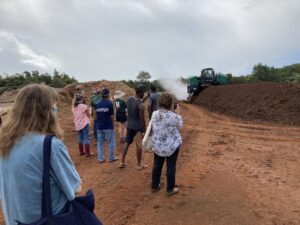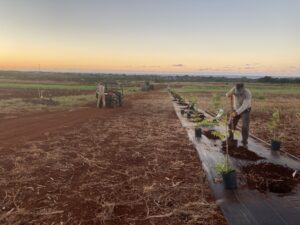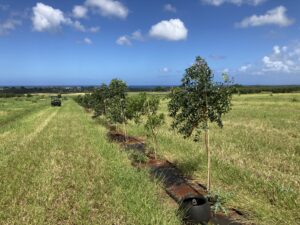Final report for WPDP19-24
Project Information
In order to elevate Hawaii’s farms to meet national standards and public expectations, Hawaii’s farmers require technical assistance and training to comply with food safety regulations and land management requirements. This initiative, “Co-Managing Food Safety and Land Stewardship on Hawaii Farms” identifies and fulfills opportunities for local farmers to comply with two common regulations: food safety requirements designed to minimize risk to consumers, and land development ordinances designed to minimize soil erosion. We assembled a team of farmers and food safety & conservation planning experts to identify, select, and demonstrate co-management practices (defined as conservation practices that simultaneously address food safety requirements) that are suitable for Hawaii’s agricultural industry. We promoted the project’s findings with farmers, conservation planners, extension agents and other agricultural professionals to increase the use of conservation practices that improve land stewardship and support food safety compliance.
Project team members identified, selected, and demonstrated management tools and best practices for Hawaii farmers to successfully co-manage food safety and land stewardship goals. Key objectives and timelines included:
- Evaluate and identify practices that simultaneously address food safety and land stewardship goals.
July - October 2019: Convene advisory panel of farmers and professionals with expertise in food safety and land stewardship
October - December 2019: Create matrix of conservation practices based on the relationship between food safety and land stewardship
- Select high priority practices based on efficacy, feasibility and viability for Hawaii’s farmers.
January - March 2020: Obtain feedback from farmers and others to select the most viable strategies
- Demonstrate the use of practices identified as supportive of both goals (co-management practices).
April - June 2020: Install on-farm demonstrations of the most viable practices
March - April 2021: Host on-farm workshops to share results (2 islands)
- Increase knowledge of co-management practices among farmers and agricultural professionals.
April - November 2020: Draft outreach materials (fact sheet, e-newsletter, articles / publications)
December 2020 - June 2021: Share information with farmers, farm advocacy groups, conservation planners, farm advisors and other agricultural professionals.
Cooperators
- (Educator)
- (Educator)
- - Producer (Researcher)
- (Researcher)
- - Producer (Educator)
Education
To educate Hawaii’s farmers and agricultural professionals about the benefits of co-management practice implementation, project leaders hosted a variety of outreach events with curated material to cater to various target audiences.
New farmers: This group was targeted by presenting the co-management guide and project overview to a local program that teaches beginning farmers the skills required to start and operate their own farms. Three presentations were held for three separate cohorts of the program. This group was also invited to attend our in-person workshops.
Experienced farmers: Farmers of this group were targeted through invitations to attend our workshops, and direct sharing of the content produced by this project such as the co-management guide. Additionally, information was shared at a Produce Safety Alliance training, available for those actively involved in growing produce. Experienced farmers also make up a large percentage of our social media audience - a channel through which we encouraged followers/readers to engage with our content.
Agricultural professionals: This group was reached through direct outreach and widespread sharing of project content, through invitations to collaborate and contribute to project outcomes, as well as through participation in an audience-specific meeting where we presented on the materials provided by the project and the ways they may be able to utilize and share information with their networks.
Education & Outreach Initiatives
Learn from food safety and conservation professionals and farmers about their experience with viable best co-management practices.
In 2019, the coordinator worked with partners from the North Shore Economic Vitality Partnership and extension agents of the University of Hawaii to cull a list of potential best co-management practices from hundreds, to just a few dozen. This process involved completing an initial matrix of potential practices, and then working together with the partners to identify that a venn diagram method was the best way to proceed (see identification process document linked below). The venn diagram categorizes those practices considered to function towards food safety, for conservation, or for both (hence a co-management practice). The reduced list of practices were ranked by agricultural professionals during interviews to identify those most relevant and viable to consider as co-management recommendations for Hawaiʻi.
Process of comanagement practice identification
The project coordinator traveled to California to visit with agricultural professionals in regard to food safety and conservation efforts. These meetings connected the coordinator with various useful resources, previous work conducted on the topic (outside of Hawaii), and provided a network of support and advice for future workshop and outreach materials.
In Hawaii, the coordinator met with local agricultural professionals in the same regard, to share the co-management approach as well as to discuss the framework of project goals and how to best disseminate useful information to local farmers.
Jacob Guth and Meaghan Donovan of California Certified Organic Farmers discuss best management practices with the coordinator (left) along with Jo Ann Baumgartner of Wild Farm Alliance (middle left), and Danny Karp of UC-Davis (middle right). Kali Feiereisel from Community Alliance with Family Farmers and Judith Redmond of Fully Belly Farm shared insights and hosted a farm tour highlighting potential co-management strategies (right).
In 2020, the project coordinator conducted interviews with local producers using the venn diagram tool and a series of questions to facilitate discussion with farmers regarding their food safety and conservation efforts. Six producers from three islands completed an interview to share their risk management approaches to food safety and existing conservation practice implementation. Each producer spoke about their current known risks to food safety, current natural resource concerns, and any related challenges they face on their individual farms, unique to their crop specialty and geographic location.
Christian Zuckerman of Kahumana Farms (left) shared how he manages risks to food safety and which best management practices he maintains that contribute to natural resource conservation. At the GoFarm student-farmer learning site in Waialua, Dan Carroll described various best management practices in place such as cover crops and windbreaks that offer benefits to food safety (middle and right).
2019
Agricultural professional interviews guided the vetting process of potential co-management processes required to prepare for farmer interviews in Hawaii.
Learning: The project partners agreed there was little benefit to farmers in reporting practices which are of low impact to both conservation and food safety. Thus, partners supported the decision to pursue creation of a venn diagram focusing on potential positive strategies rather than a matrix which displays a spectrum including low-impact practices. Resources were acquired from partners on previous co-management research to assist in decision making.
Action outcomes: Material generated to draft prioritization matrix (venn diagram) deliverable.
Impact: Provided a more concise list of practices to take to farmers for their input and hence to use their time more efficiently.
2020
Six producers from three islands contributed valuable insight to the project researchers regarding which potential best management practices are suitable for co-management goals in Hawaii.
Learning: Multiple farmers shared similar feedback on the conflicting impacts of some potential co-management practices and cautioned that suggestions should always be presented on a case-by-case basis, unique to the farmer's goals, resources, and farm conditions. Overall, the producers shared how goals to reduce runoff and improve soil health are often a co-management win-win for the farm, and to focus on practices that target those issues.
Action outcomes: Material gathered from this process of interviews shaped the final recommended suite of practices to be included in a guidance document.
Impact: Development of the outreach resource will be more relevant and useful to farmers after being vetted and reviewed by farming partners.
Produce documents based on research and farmer feedback to use as a foundational resource for sharing co-management strategies.
Guided by farmer insight, the coordinator collaborated with extension agents in 2020 to create a comprehensive educational guide that utilized the knowledge and data gathered from farmers and agricultural professionals. With a target audience of farmers in Hawaii, the major focuses of the outreach materials were to 1) keep the information relevant 2) provide useful information 3) and deliver it at the appropriate level of depth. This meant that the materials produced were evaluated to ensure that a farmer would 1) find interest in the material and continue reading 2) be provided with solutions and descriptions of how to apply the new information and 3) find the material practical in regard to the farmer's priorities and incentives.
A guide was developed that summarized major risks to food safety and natural resource conservation and introduced how co-management can aid in supporting farmers with goals to improve these areas of concern. It introduced seven suggested practices that a farmer may be interested in implementing on their own farm, and what things they should keep in mind when considering it. The guidance document also demonstrates how a farmer can incorporate co-management efforts into a food safety plan by providing example language for each practice. The guide entitled “Food Safety and Conservation Co-Management: A Guide for Hawaii Growers” was published by the University of Hawaii College of Tropical Agriculture and Human Resources (UH CTAHR) Cooperative Extension (A Food Safety and Conservation Co-Management Guide for Hawai‘i Growers)
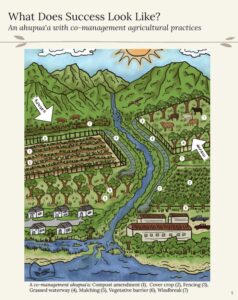 The suggested practices included in the document were illustrated within a Hawaiian co-management ecosystem (above), including compost amendment, cover crop, fencing, grassed waterway, mulching, vegetative barrier, and windbreak.
The suggested practices included in the document were illustrated within a Hawaiian co-management ecosystem (above), including compost amendment, cover crop, fencing, grassed waterway, mulching, vegetative barrier, and windbreak.
In addition to this published guide, seven fact sheets (Full Fact Sheet Series of Co-Management Practices) were created that summarize and highlight each individual practice’s contribution to a co-management farm strategy.
Learning: Recommendations for co-management strategies truly cannot have a one-size-fits-all approach, and the value of on-site support in addition to the use of this informational resource is still vital to the success of the user. Additionally, the void of literature published with a focus on Hawaii food safety and natural resource conservation solutions was evident after this process of the project. Many studies used to produce the guide document had to be adapted from mainland research and extrapolated to find relevance to the Hawaii farm community. It was apparent to project researchers that there is a need for co-management techniques to be further studied and evaluated for the tropics and the result of which would likely increase farmer adoption.
Action outcomes: Currently, the guidebook has been downloaded 58 times since its launch in November of 2020 and 20 printed copies were distributed to interested workshop participants.
Impact: The published guidebook and fact sheet series are available for the farming community in Hawaii to reference as a reliable resource for implementing co-management strategies. These resources can also direct interested farmers to the network of aid available locally who they may contact for greater assistance and information. An increased interest in such work may also encourage the academic community to conduct more research in this field and improve our location-specific understanding of impact.
Expand the network of farmers in Hawaii that are interested in co-management strategies
In 2020 and 2021, the guidance document was shared in the Oahu RC&D monthly newsletter, and published in January of 2021 within the University of Hawaii Cooperative Extension (College of Tropical Agriculture and Human Resources). Throughout the year, 15 social media posts and six newsletter articles were shared with our cooperator network to introduce the recommended co-management practices as well as introduce the availability of the co-management guide for Hawaii producers. In November of 2020, the project findings and guidance document were also virtually presented at the Hawaii Farmers Union United (HFUU) conference.
The coordinator attended a Produce Safety Alliance grower training course, as well as a Food Safety Modernization Act workshop on Oahu to share project goals and network with local farmers and professionals that may be interested in integrating conservation practices into food safety management. Additionally, community agricultural events with other organizations provided opportunities to discuss project goals and connect with farmers including attendance to events hosted by GoFarm, Kokua Hawaii Foundation, and Waimanalo Agricultural Association.
In 2021, the project coordinator hosted five virtual presentations with target audiences (new farmers, experienced farmers, and agricultural professionals) to review the guidance document materials and communicate how these resources can be shared and utilized with others in the farming community.
Two producers participated in an on-farm demonstration installation of a recommended practice. On Big Island, a producer installed a vegetative barrier of vetiver to stabilize soil and reduce risk of contaminated runoff from reaching an stream adjacent to where her cattle graze (below).
On Oahu, another producer installed a windbreak to improve the orchards biodiversity and reduce irrigation waste, and reduce risk of airborne contaminants on the property (below).
Two workshops were also hosted to share the project outcomes and to demonstrate a best management practice in-person. Workshop participants toured Go Farm in Waialua on Oahu to see four co-management practices in place and learned how to calculate C:N ratios and create their own compost piles (below).
On Kauai, participants gathered at Green Earth Matters composting facility to learn about co-management and how to safely create and apply compost (below). Guests also went on a tour of the facility and saw a demonstration of a windrow compost pile being turned. In the lower right photo, we see steam from the compost pile is let off as the turner aerates the material.
To extend the audience of our work, the project also developed a “how to” video on windbreak installation at our demonstration site with Hua Orchards. This informational video was shared with workshop participants and the greater social media network which highlighted the step-by-step process to implement a popular co-management practice. The video describes in detail how to prepare a site, select the appropriate location and materials, and how to complete the installation and maintenance of a windbreak.
Watch the “Windbreak Installation” Video on YouTube.
Learning: Farmers were able to learn about new ways to mitigate risks to food safety and to improve their natural resources on site, and were provided with an opportunity to ask questions. At our workshops, participants were able to experience the methods of maintaining a co-management practice hands on.
Action outcomes: Thousands of subscribers to our social media, dozens of attendees to our presentations, and dozens of workshop participants were exposed to the concept of co-management goals and strategies in Hawaii.
Impact: Farmers in Hawaii are encouraged to consider implementing co-management strategies on their farms. Information shared virtually as well as in-person opportunities to answer questions and learn tangible actions creates an opportunity for local farmers to be exposed to and explore if co-management practices are right for them. If so, farmers were provided the resources to implement these practices.
Educational & Outreach Activities
Participation Summary:
Learning Outcomes
Project Outcomes
A Food Safety and Conservation Co-management Guide for Hawaii Growers
Full Fact Sheet Series of Co-Management Practices
Windbreak Installation Instructional Video
The interviews held with farmers across the state helped to generate a guidance document and a fact sheet series on co-management practices, as well as an informational video of the installation of one popular practice. Practices were chosen as co-management strategies if producers considered them to be practical in Hawaii, which has distinctive growing conditions from the continental US, and which were already vetted for their ability to address food safety concerns and conservation of natural resources.
The outcome of this work resulted in increased farmer exposure to co-management strategies as well as the adoption of new practices for the funded demo sites. In addition to the opportunities made available for the farming community to learn more about this work during the project duration, the content generated from the project will remain available and will continue to be shared with our farmer and agricultural professionals networks. Our partners on Oahu as well as the new connections made in California have shared their utilization of the guidance document in their work, and that they plan to continue integrating the content for their audiences.
While there was overlap of practices considered in both categories of farm goals, it was noted that many practices best suited for food safety were unrelated to those best suited for conservation goals and vice versa. This observation introduced the need to reevaluate the impact of the project initiative to identify clear overlapping practices. Co-management practices were evaluated further in farmer interviews. Despite this challenge, the necessity of addressing both concerns remains of clear importance in Hawaii to support a sustainable agriculture system. Identifying cases in which food safety and conservation practices run counter to each other helps to flag important challenges for farmers and those supporting them in one or both of these areas, while preventing unrealistic recommendations (i.e. the adoption of a conservation practice that undermines food safety).
Recommended practices for conservation highlight the overall improvement to an ecosystem that can be attained, which can encourage healthy plant communities and food safety, however, the marriage of these two concepts is often challenged in real-world agriculture. Examples of such realized challenges for Hawaii specifically were: small acreage plots, short land leases, limited commercial distributors that must comply with FSMA food safety standards, and year-round growing seasons. The outcomes of this initiative have provided valuable insight into this challenge, as it was not previously well-defined, and have also encouraged the opportunity to share co-management strategy information in a more visual and cohesive way for participating farmers.
An important outcome from this work has been to better understand the limitations of farmers to implement new practices on their farms, and the ongoing complexities of decision-making they face. By providing a concise list of practices and identifying the candid pros and cons of each in regards to food safety as well as conservation, this project supports farmers in their decision-making process by equipping them with relevant information and feedback generated by a community of farmers.
- Much of the current existing data related to the benefits of co-management on farms has been in regions not closely related to the microclimates and agricultural culture of Hawaii. We encourage the academic community to explore and provide a better understanding of the impact co-management practices may have specifically on Hawaii farms related to food safety and/or conservation of natural resources.
- Co-management on farms is not a one-size-fits-all opportunity. When considering new farm practices, it is recommended that farmers consult with a technical service provider in the area to aid in customizing how suggested best management practices may or may not be suitable for a specific site. Implementing a new practice may incur costs or undesired consequences, and having assistance to understand how a standard practice may or may not be cost effective and practical for a farmer should be closely examined.
Information Products
- A Food Safety and Conservation Co-Management Guide for Hawai‘i Growers (Manual/Guide)
- Windbreaks for Co-Management (Fact Sheet)
- Vegetative Barriers for Co-management (Fact Sheet)
- Mulching for Co-Management (Fact Sheet)
- Grassed Waterways for Co-Management (Fact Sheet)
- Fencing for Co-Management (Fact Sheet)
- Cover Crops for Co-Management (Fact Sheet)
- Compost Amendments for Co-Management (Fact Sheet)
- Full Fact Sheet Series of Co-Management Practices (Fact Sheet)
